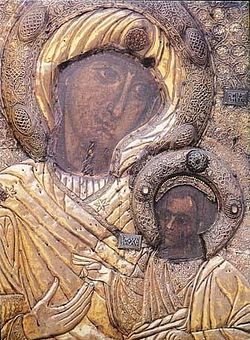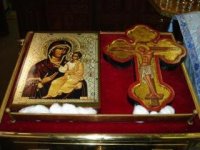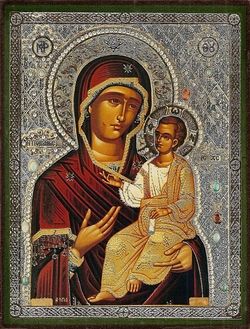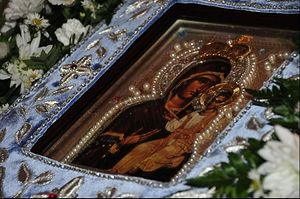 The Panagia Portaitissa, or Iveron icon of the Mother of God, Mt. Athos.
The Panagia Portaitissa, or Iveron icon of the Mother of God, Mt. Athos.
To save the icon from further violence, after long prayer the widow cast the icon into the sea. It sailed to the holy mountain of Athos, the “Garden of the Panagia”. The monks one day saw a pillar of light over the sea, and looking closer, beheld the icon of the Theotokos. Only one monk, however, was worthy of receiving it into his hands—the Georgian monk Gabriel from the Iveron monastery. (The Iveron Monastery was so named because it was a Georgian monastery, “Iveron” or Iberia being the name of their homeland, Georgia). The icon was placed in the church, but the Mother of God informed the monks that she wished her icon to be placed over the gates, and thus the icon came to be known as “Keeper of the gate”.
In 1648, news of this wonder-working Icon reached Russia through pilgrims who had visited Mt. Athos. Then Patriarch Nikon of Moscow commissioned an exact copy of the Iveron icon to be made and sent to Russia. Almost immediately upon its arrival on October 13 [October 26, new style], the icon was glorified with numerous miracles attributed to it by the faithful. This day is still commemorated as the feast of the Translation of the Iveron icon to Moscow. The Iveron Chapel was built in 1669 to enshrine the icon next to the Kremlin walls in Moscow. The chapel was the main entrance to Red Square and traditionally everyone, from the Tsar down to the lowest peasant would stop there to venerate the icon before entering the square. After the Bolshevik Revolution of 1917, the chapel was destroyed by the Bolsheviks and the fate of the icon is unknown to this day. A new copy was made on Mt. Athos in recent years, and placed in the newly restored Iveron chapel by the gates of the Kremlin, where Akathists to the Mother of God are served from morning to evening daily.
Another newer version of the famous Portaitissa is the Myrrh-streaming icon from Montreal in Canada. For fifteen years, between 1982 and 1997, myrrh continually flowed from this Icon. Brother José Muñoz-Cortes devoted himself to the care and protection of this icon, and accompanied it on numerous trips to parishes all over the United States and Canada, South America, Australia, and Europe.[1]
In 2007, the Most Holy Mother of God showed her grace once again upon the new world through her Iveron icon, this time on a Hawaiian island. On this feast of the Iveron icon, we cite here the story of this outpouring of grace from the website of the Church of the Iveron Mother of God in Honolulu, a parish of the Russian Orthodox Church Abroad.
* * *
A Letter from the Reader Nectarios concerning the miraculous Myrrh-streaming icons of the Iveron Mother of God:
Dear beloved in Christ,
In humility and with extreme trepidation, I will attempt to relate to you what actually occurred before rumors spread, evolve, and eventually become untruths. Many have asked me to explain the events that have taken place in recent weeks regarding the two myrrh-streaming icons at the Holy Theotokos of Iveron Russian Orthodox Church in Honolulu, Hawaii. It has been hard to put into words the recent events that have taken over my life. I can't imagine how others would have reacted if they were in my shoes, God only knows. I pray God will guide me, and my family, to do and say things that are not contrary to His Will. I will attempt to tell the story of how these humble icons came into my life and how they changed it. Everything I write here is true.
The icons in question are two:
1) One is a mounted-print made, I believe, at the Sofrino Church factory near Moscow. It is an exact copy of the Montreal Myrrh-streaming Iveron Icon of the Holy Theotokos; this was the icon cared for by Blessed Martyr Brother José Muñoz. It is a small icon, roughly 7 x 9 inches and approximately one inch thick. My parish priest, Fr. Anatole Lyovin, gifted it to me for my Name's Day [in 1997]. He said he purchased it at a church bookstore in Toronto when the parish in which he had grown up celebrated the fiftieth anniversary of its founding. The icons from Sofrino have a distinctive style with a beautiful silk-screen riza (or oklad in Russian, Pokamiso in Greek) built into the icon. This is done so that those who cannot afford beautiful and very expensive icons can have something equally beautiful from Sofrino for less.
2) The second icon is a hand-painted icon in the shape of a Cross, with the image of Our Lord's crucifixion in the traditional Byzantine style of iconography. A Greek monk from the Holy Mountain Athos painted it. It is roughly 8 x 11 inches and approximately 1 1/2 inches thick. I purchased a set of two near identical Cross icons and gave one to my father as a gift; I kept the other.
Before I relate to you the full story of the icons, let me say how it all began …

Now on to the most recent developments in my story …
During the last week of September I began to notice an unbelievably strong smell of myrrh, at home, in my car, even at work. I couldn't explain it. Was it all in my head? I asked my wife and she said she didn't smell anything. I spoke with several other people who visited our home, and they too said they didn't smell anything. (One of these people was our Serbian Orthodox kuma—she, too, couldn't smell anything.) I was convinced it was all in my imagination. This was on September 27th, the feast of the Exaltation of the Cross.
Then in the first week of October, my wife and I were extremely ill and missed Vespers that night. We don't miss too many of the church's divine services, so we did take notice of the date, October 6th (Feast day of the Conception of St. John the Baptist). Around 10:30 p. m. that night, I was working in my office, which also doubles as our home chapel where our icon corner is located. My cat walked into the office and began to sniff around as if he smelled something. I did not smell anything. He proceeded to walk toward the area were our family reliquaries are kept. I thought this was strange since he would never go near the reliquaries; amazingly something always stopped him, and he's a nosy cat. Yet this time he stood on his hind legs and sniffed around, I assume in order to figure out what the smell was. I still didn't smell anything. I proceeded to pick him up and then I noticed the scent. It was so strong, even overwhelming. Never have I smelled anything like that in my life. I couldn't explain why I hadn't smelled it before. It was like a thousand roses had fallen into the room. I crossed myself and guarded myself with the Jesus Prayer. I put the cat down and proceeded to look at the icons. I admit I was afraid to look at the icons near the reliquaries. I finally came to the icon of the Cross and noticed that the bead of myrrh by the side-wound of Christ was still dry, for a split second I regained some composure, even as the smell of roses was getting stronger. I then looked down and my hand was wet—it was myrrh. How did it get there? The icon was dry? Or was it? I then noticed that the left knee of the image of Our Lord was forming a bead of myrrh right before my eyes. I then called out to my wife. She came running, and when I asked her if she had spilled anything on the icons, she said no. She hadn't gone near them. I showed her the icon. She was in shock. I told her the smell is too strong. Help me look at the other icons. So she did. In my office I have two bookshelves, at the top of them are icons. We have many icons, maybe too many. I stood on my toes to reach for the icons at the top of my bookshelves. My wife did the same. Finally I grabbed the icon of Iveron given to me by Fr. Anatole. It was completely wet. And then the smell got even stronger. Even my wife could smell it. For those of you who don't know my wife, her sense of smell is very limited; she is only capable of smelling citrus scents. We were afraid. We asked one another if we cleaned or anointed the icons recently, and both of us said “no”. “What is going on?” I asked. I put the icons back where they were; we took a few pictures with our digital camera. Then I said an Akathist to the Mother of God in honor of her Iveron Icon and went to bed, or at least tried to.
 The Iveron Montreal, Hawaii Mother of God.
The Iveron Montreal, Hawaii Mother of God.
We couldn't wait until Wednesday.
On Wednesday October 10th, we brought the icons to church and placed them on two analogia (lecterns) in the center of the church. Fr. Anatole inspected them and wiped them down with cotton and proceeded to start the service of the Akathist Hymn of the Iveron Icon. After the service, the icons were wiped down again; they had streamed a little during the service. Fr. Anatole confirmed to us that it is “definitely streaming myrrh” and that it is “a very pure myrrh”. The smell of roses filled the air. I asked him what we were to do? He asked us to leave the icons in church for the time being. No one knew about the icons; they were safe at church.
The next Saturday, October 13th, just happened to be "clean the church day". We were preparing our church for the upcoming feasts; our parish feast day (November 24), Christmas, the Serbian bishop's visit, etc. So my wife, myself and another person were put in charge of cleaning. While we were cleaning the church we couldn't take our eyes off the two myrrh-streaming icons, which slowly streamed while we were cleaning. The smell of roses was quite pungent. The icons seemed to exude a strong smell of roses. The Icon of the Mother of God seems to smell more like “roses” than the other icon. The Cross has a spicier smell to it. I can't explain it. While we were cleaning the church, our kumovi, came to see the icons. Not many folks could wait for Vespers that evening. Our kuma later remarked to me that she's the “doubting Thomas” and really couldn't believe it until she saw it for herself. Understandable. She didn't realize that the icons were actually streaming as we were cleaning. (They don't stream continuously.) She venerated the Cross and kissed the feet of Our Lord. She got a nice helping of myrrh in her mouth. Like the doubting Apostle Thomas who put his fingers in Christ's Hands and Side, she put her mouth right in the myrrh, where myrrh wasn't supposed to be! I couldn't help but laugh.
The next day, Sunday October 14th, was the Feast of the Protection of the Mother of God, and Fr. Anatole revealed the icons to the people. The icons streamed quite heavily; there was enough myrrh for everyone. They have continued streaming ever since. Many have come to see the icons, Russians, Greeks, Serbs, Roman Catholics, Protestants. All who approach the icons feel the Grace of God! There have been days when the icons have been completely dry, while on other days they are covered in myrrh. Yet whether they stream or not, they continuously give off an extremely strong scent of roses. It is truly a great miracle! I sometimes wonder if it is a warning.
Now that I look back, it seems that “revelation” has been the central theme of late. We revealed the fragrance to our kumovi on the Feast of the Exaltation of the Cross. We found the icons giving myrrh and revealed them to our priest on the Feast of the Conception of St. John the Baptist. He was the one man who revealed Christ to the world. Our priest revealed the myrrh-streaming icons to the church on the Feast day of the Protection of the Mother of God. These cannot be coincidences!
Our parish is dedicated to the original Myrrh-streaming Iveron Icon, an icon that had never traveled to Hawaii. Br. José wanted to come here, but never made it. I must confess to you, sometimes I feel that our fellow Orthodox brethren on the mainland have forgotten our little parish, our little community. Living out here in the middle of the Pacific Ocean, we struggle to survive as an Orthodox parish. Struggle to pay the bills, struggle to make the rent. I sometimes wonder, when will we have a church of our own? Has the Lord forgotten us? Are we to struggle forever? Have we done something wrong? Have we angered You, O Lord? Whether or not our fellow clergy, our fellow Orthodox faithful have forgotten us, one thing is clear… The Most Holy Mother of God has not forgotten us. She has not abandoned us. She will not abandon us! Through these icons, I now have hope that there IS a light at the end of the tunnel. Whether or not we are blessed to have a church of our own, it really doesn't matter; God has shown us that He has not forgotten us! And that's all that is needed. God is telling us that He is real! Dare we ignore this revelation? Dare we turn our backs on this great miracle? Dare we forget Christ? May God forgive us if we do!
In Christ's Love,
Rdr. Nectary
(December 2007)
UPDATE: August 2011
In June of 2008, the “Hawaiian” Myrrh-streaming Iveron Icon was officially recognized by the Russian Orthodox Church Outside Russia as miraculous and worthy of veneration, and was given the blessing to travel to the various churches and monasteries of Holy Orthodoxy. The original “owner” of the Icon, Reader Nectarios, was charged by the Russian Orthodox Church to be Her guardian, and provide for the safety and care of this Wonderworking Icon of Christ’s Holy Church.
By the Grace of God, the Holy Cross has slowly ceased to continuously stream Myrrh as it once did, now doing so on certain occasions throughout the year, Pascha being the most recent. What is comforting to the faithful is the Holy Cross still continuously provides a beautiful and pungent fragrance of roses, whether it streams or not. While the "Hawaiian" Iveron Icon travels and brings the grace of the Mother of God to various places, the Holy Cross always remains in Hawaii to provide for the protection and veneration of the faithful.
Since June of 2008, She has been to over 250 churches in America of all (canonical) jurisdictions, and has been venerated by an estimated quarter of a million people throughout the United States. In many cities, the holy Icon is taken from one parish to another, being shared by all the Orthodox clergy, and in doing so, helping to establish relationships where none existed before, and to strengthen and foster ties already made between the sister parishes. Requests have now been made for the Wonderworking Icon to be brought to Russia, Greece, the Ukraine, South America, Canada, the Holy Land, Romania, Georgia, Mount Athos, and Serbia.
Numerous miracles have been attributed to the Theotokos through this “humble little Icon”, accounts are only just being collected, and are indeed numerous. Physical and spiritual healings have included the healing of blindness and eye disease, cancer, demonic possession, paralysis, kidney disease, chronic pain, and debilitating viruses.
Yet, wherever the holy Icon goes, the Grace of Our Lord Jesus Christ and His Holy Mother abound. People have commented that just being in the presence of this Icon, you feel such an abundance of love and joy. It is truly indescribable. To quote Archbishop Justinian of Naro-Fominsk (MP), “the faithful need to see this Icon!”
Troparion to the Iveron Icon, Tone 7
From thy Holy Icon, O Lady Theotokos, blessed myrrh has flowed abundantly. Thou hast thereby consoled those, in exile, faithful unto thee, and hast enlighten the unbelievers by thy Son's light. Therefore O Lady, with tears we bow down to thee. Be merciful to us in the hour of judgment. Lest having received thy mercy we be punished as those who have been contemptuous of it. But grant us through thy prayers to bring forth spiritual fruit, and save our souls.




